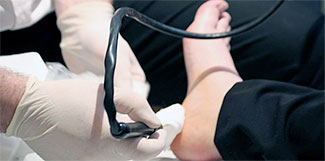- Home
- Advanced Treatments
- Cryotherapy
Cryotherapy for Morton's Neuroma and Plantar Fasciitis
- Published 11/27/2018
- Last Reviewed 2/5/2025

What is cryotherapy ablation?
Cryotherapy (also known as cryosurgery or cryoablation) is a state-of-the-art treatment that uses extremely low temperatures to painlessly destroy nerve tissue. Cryotherapy nerve blocks stop the transmission of pain signals to the brain and relieve pain.
Despite its benefits, cryotherapy is not widely offered by foot and ankle practices. The main barrier is the high cost of the cryotherapy machine and its specialized equipment, making it a significant investment. Additionally, performing the procedure requires specialized training and expertise, further limiting its availability. UFAI is proud to offer cryotherapy at its Santa Monica location.
- What foot conditions does cryotherapy ablation treat?
- How does cryotherapy for Morton's neuroma work?
- What to expect during cryotherapy nerve ablation?
- What to expect after cryotherapy ablation?
- Are there risks with cryotherapy?
- Why trust University Foot and Ankle Institute for cryotherapy near me?
- Cryotherapy FAQs
- What type of sedation is used during nerve ablation?
- What happens if nerve ablation doesn't work?
- What is the success rate of cryotherapy for Morton's neuroma treatment?
-
ABFAS® Board Certified in Foot and Ankle Surgery and Co-Director of University Foot and Ankle Institute
Board-Certified Podiatric Foot and Ankle Specialist, Dr. Gary Briskin, DPM, FACFAS, began his medical training by serving a residency at Flint General Hospital in Michigan. Once completed, he established a practice in Century City Hospital, where he soon became chief of podiatric surgery.
Dr. Briskin is a Diplomat of the American Board of Podiatric Surgery and a Fellow of the American College of Foot and Ankle Surgeons. He also serves as an assistant clinical professor at the UCLA School of Medicine and is co-founder and co-director of University Foot and Ankle Institute.
 On time appointments, Dr. Jafary is calm when explaining problem and patient with my questions. I have recommended family membe...Virginia B.
On time appointments, Dr. Jafary is calm when explaining problem and patient with my questions. I have recommended family membe...Virginia B. I liked it.Liisa L.
I liked it.Liisa L. The doctor (Dr. Bob Baravarian) and his entire staff are wonderful. I have benefited tremendously by the expertise of this surg...Brandy A.
The doctor (Dr. Bob Baravarian) and his entire staff are wonderful. I have benefited tremendously by the expertise of this surg...Brandy A. I depend on the doctors at UFAI to provide cutting edge treatments. Twice, I have traveled from Tucson, Arizona to get the car...Jean S.
I depend on the doctors at UFAI to provide cutting edge treatments. Twice, I have traveled from Tucson, Arizona to get the car...Jean S. They helped me in an emergency situation. Will go in for consultation with a Dr H????
They helped me in an emergency situation. Will go in for consultation with a Dr H????
Re foot durgeryYvonne S. Very smooth experience! Nice people.I went in for some foot pain from a sports collision. Dr. Feldman saw me very soon after I ...Henry G.
Very smooth experience! Nice people.I went in for some foot pain from a sports collision. Dr. Feldman saw me very soon after I ...Henry G. It went very smoothly.Maria S.
It went very smoothly.Maria S. My experience at the clinic was wonderful. Everybody was super nice and basically on time. Love Dr. Bavarian and also love the ...Lynn B.
My experience at the clinic was wonderful. Everybody was super nice and basically on time. Love Dr. Bavarian and also love the ...Lynn B. I fill I got the best service there is thank youJames G.
I fill I got the best service there is thank youJames G. My experience with your practice far exceeded any of my expectations! The staff was always friendly, positive and informative. ...Christy M.
My experience with your practice far exceeded any of my expectations! The staff was always friendly, positive and informative. ...Christy M. Love Dr. Johnson.Emily C.
Love Dr. Johnson.Emily C. I am a new patient and felt very comfortable from the moment I arrived to the end of my visit/appointment.Timothy L.
I am a new patient and felt very comfortable from the moment I arrived to the end of my visit/appointment.Timothy L.
